Development of Rock Embedded Drilled Shaft Resistance Factors in Korea based on Field Tests
Abstract
1. Introduction
2. Evaluation of Resistance for the Drilled Shaft
2.1. Collected Load Test Data
2.2. Procedures for Determination of Measured Resistance
2.3. Calibration for Load Test Transfer Analysis
2.4. Calibration for the Equivalent Load-Displacement Curve
2.5. Measured Resistance from the Load Test Results
2.6. Predicted Resistance Values Obtained using Bearing Capacity Equations
3. Determination of Resistance Factors
3.1. Determination of Statistical Parameters
3.1.1. Load Statistics
3.1.2. Resistance Statistics
3.2. Determination of Target Reliability Index
3.3. Determination of Resistance Factors
4. Conclusions
Author Contributions
Funding
Conflicts of Interest
References
- Abu-Farsakh, M.Y.; Yu, X.; Zhang, Z. Calibration of side, tip, and total resistance factors for load and resistance factor design of drilled shafts. Transp. Res. Rec. J. Transp. Res. Board 2012, 2310, 38–48. [Google Scholar] [CrossRef]
- Basu, D.; Salgado, R. Load and resistance factor design of drilled shafts in sand. J. Geotech. Geoenviron. Eng. 2012, 138, 1455–1469. [Google Scholar] [CrossRef]
- Ministry of Construction and Transportation. Korea Highway Bridge Design Code (Limit State Design); Korea Road and Transportation Association: Seoul, Korea, 2012. (In Korean) [Google Scholar]
- AASHTO. AASHTO LRFD Bridge Design Specifications, 6th ed.; AASHTO: Washington, DC, USA, 2015. [Google Scholar]
- Long, J.; Hendrix, J.; Baratta, A. Evaluation/Modification of IDOT Foundation Piling Design and Construction Policy; Rep. No. ICT-09-037; Illinois Center for Transportation: Rantoul, IL, USA, 2009. [Google Scholar]
- Garder, J.A.; Ng, K.W.; Sritharan, S.; Roling, M.J. Development of a Database for Drilled SHAft Foundation Testing (DSHAFT); Rep. No. InTrans 10-366; Institute for Transportation, Iowa State University: Ames, IA, USA, 2012. [Google Scholar]
- Stanton, K.; Motamed, R.; Elfass, S. Robust LRFD resistance factor calibration for axially loaded drilled shafts in Las Vegas. J. Geotech. Geoenviron. Eng. 2017, 143, 06017004. [Google Scholar] [CrossRef]
- Kim, S.J.; Kwon, O.S.; Jung, S.J.; Han, J.T.; Kim, M.M. Determination of Resistance Factors of Load and Resistance Factor Design for Drilled Shaft Based on Load Test. J. Korean Geotech. Soc. 2010, 26, 17–24. [Google Scholar]
- Korea Institute of Construction Technology (KICT). Determination of Resistance Factors for Foundation Structure Design by LRFD; Research Policy/Infrastructure Development Program, Ministry of Land, Transport and Maritime Affairs: Seoul, Korea, 2008. [Google Scholar]
- Jung, S.J. Calibration of Resistance Factors of Load and Resistance Factor Design for Drilled Shafts Embedded in Weathered Rock. Ph.D. Thesis, Seoul National University, Seoul, Korea, 2010. [Google Scholar]
- Kim, D.W.; Chung, M.K.; Kwak, K.S. Resistance factor calculations for LRFD of axially loaded driven piles in sands. KSCE J. Civ. Eng. 2011, 15, 1185–1196. [Google Scholar] [CrossRef]
- Park, J.H. Resistance Factor Calibration and Bayesian Implementation for LRFD of Axially-Loaded Driven Steel Pipe Piles. Ph. D. Thesis, Seoul National University, Seoul, Korea, 2011. [Google Scholar]
- Park, J.H.; Huh, J.W.; Kim, K.J.; Chung, M.K.; Lee, J.H.; Kim, D.W.; Kwak, K.S. Resistance Factors Calibration and Its Application using Static Load Test Data for Driven Steel Pipe Piles. KSCE J. Civ. Eng. 2013, 17, 929–938. [Google Scholar] [CrossRef]
- Kim, H.T.; Kim, D.H.; Lim, J.C.; Park, K.H.; Lee, I.H. Resistance Factor and Target Reliability Index Calculation of Static Design Methods for Driven Steel Pipe Pile in Gwangyang. J. Korea Acad.-Ind. Coop. Soc. 2015, 16, 8128–8139. [Google Scholar]
- Park, J.B.; Kwon, Y.H. Estimation of Resistance Coefficient of PHC Bored Pile by Load Test. LHI J. 2017, 8, 233–247. [Google Scholar]
- Kim, D.G.; Kim, H.T.; Suh, J.W.; Yoo, N.J. Analysis of LRFD Resistance Factor for Shallow Foundation on Weathered Soil Ground. J. Korean Geo-Environ. Soc. 2015, 16, 5–11. [Google Scholar]
- Kim, D.G.; Hwang, H.S.; Yoo, N.J. Comparison of Safety Margin of Shallow Foundation on Weathered Soil Layer According to Design Methods. J. Korean Geo-Environ. Soc. 2016, 17, 55–64. [Google Scholar] [CrossRef][Green Version]
- Fellenius, B.H. Tangent modulus of piles determined from strain data. In Proceedings of the ASCE Geotechnical Engineering Division Foundation Congress, Evanston, IL, USA, 25–29 June 1989; pp. 500–510. [Google Scholar]
- Kwon, O.S.; Choi, Y.K.; Kwon, O.K.; Kim, M.M. Method of Estimating Pile Load-displacement Curve Using Bi-directional Load Test. J. Korean Geotech. Soc. 2006, 22, 11–19. [Google Scholar]
- Yu, X.; Abu-Farsakh, M.Y.; Yoon, S.M.; Tsai, C.; Zhang, Z. Implementation of LRFD of drilled shafts in Louisiana. J. Infrastruct. Syst. 2011, 18, 103–112. [Google Scholar] [CrossRef]
- O’Neill, M.W.; Reese, L.C. Drilled Shafts: Construction Procedures and Design Methods; FHWA-IF-99-025; FHWA: Washington, DC, USA, 1999.
- Gupta, R.C. Hyperbolic Model for Load Tests on Instrumented Drilled Shafts in Intermediate Geomaterials and Rock. J. Geotech. Geoenviron. Eng. 2012, 138, 1407–1414. [Google Scholar] [CrossRef]
- ASCE. Standard Guidelines for the Design and Installation of Pile Foundations; ASCE 20-96; ASCE: Reston, VA, USA, 1997. [Google Scholar]
- Carter, J.P.; Kulhawy, F.H. Analysis and Design of Drilled Shaft Foundations Socketed into Rock; Report EL-5918; Electric Power Research Institute: Palo Alto, CA, USA, 1988. [Google Scholar]
- Horvath, R.G.; Kenney, T.C. Shaft resistance of rock-socketed drilled piers. In Symposium on Deep Foundations; ASCE: Atlanta, GA, USA, 25 October 1979; pp. 182–214. [Google Scholar]
- Rowe, R.K.; Armitage, H.H. A design method for drilled piers in soft rock. Can. Geotech. J. 1987, 24, 126–142. [Google Scholar] [CrossRef]
- Zhang, L.; Einstein, H.H. End bearing capacity of drilled shafts in rock. J. Geotech. Geoenviron. Eng. 1998, 124, 574–584. [Google Scholar] [CrossRef]
- Paikowsky, S.G. Load and Resistance Factor Design (LRFD) for Deep Foundations; NCHRP Report 24-17; Transportation Research Board: Washington, DC, USA, 2004. [Google Scholar]
- Hasofer, A.M.; Lind, N.C. Exact and invariant second moment code format. J. Eng. Mech. Divis. 1974, 100, 111–121. [Google Scholar]
- Ministry of Land, Transport and Maritime Affairs. Korea Structure and Foundation Structure Design Specification; Korean Geotechnical Society: Seoul, Korea, 2003. (In Korean) [Google Scholar]
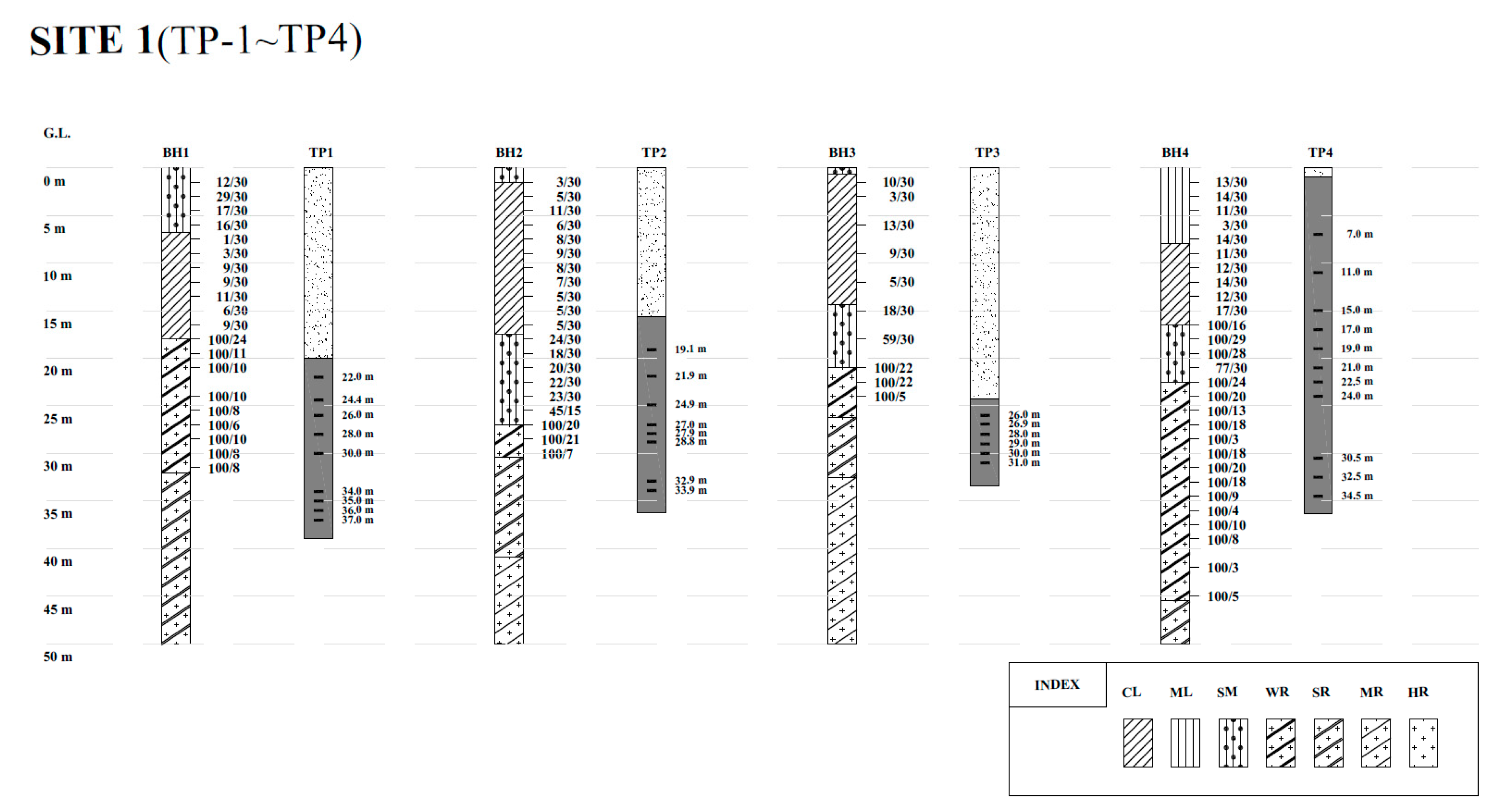
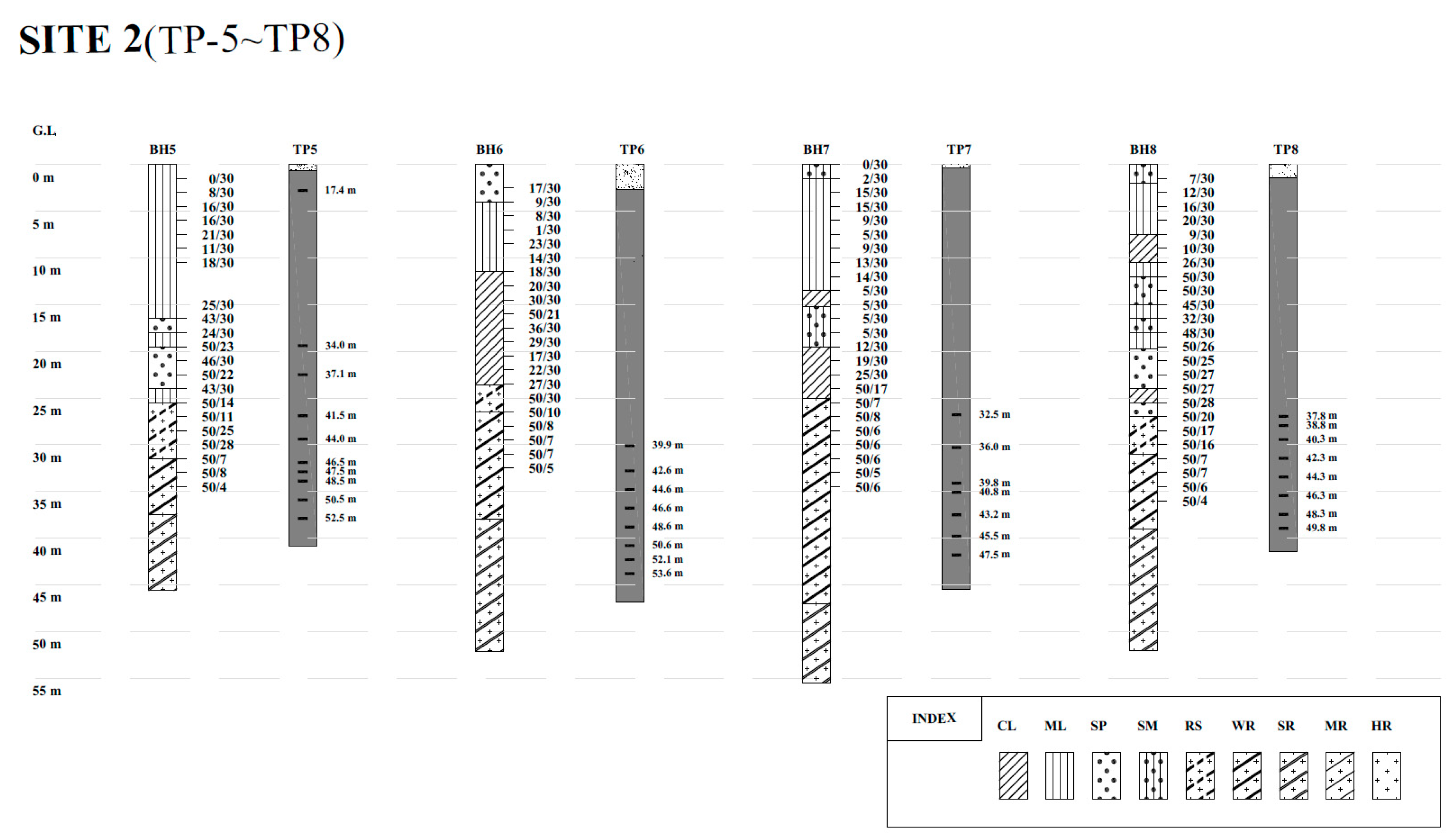


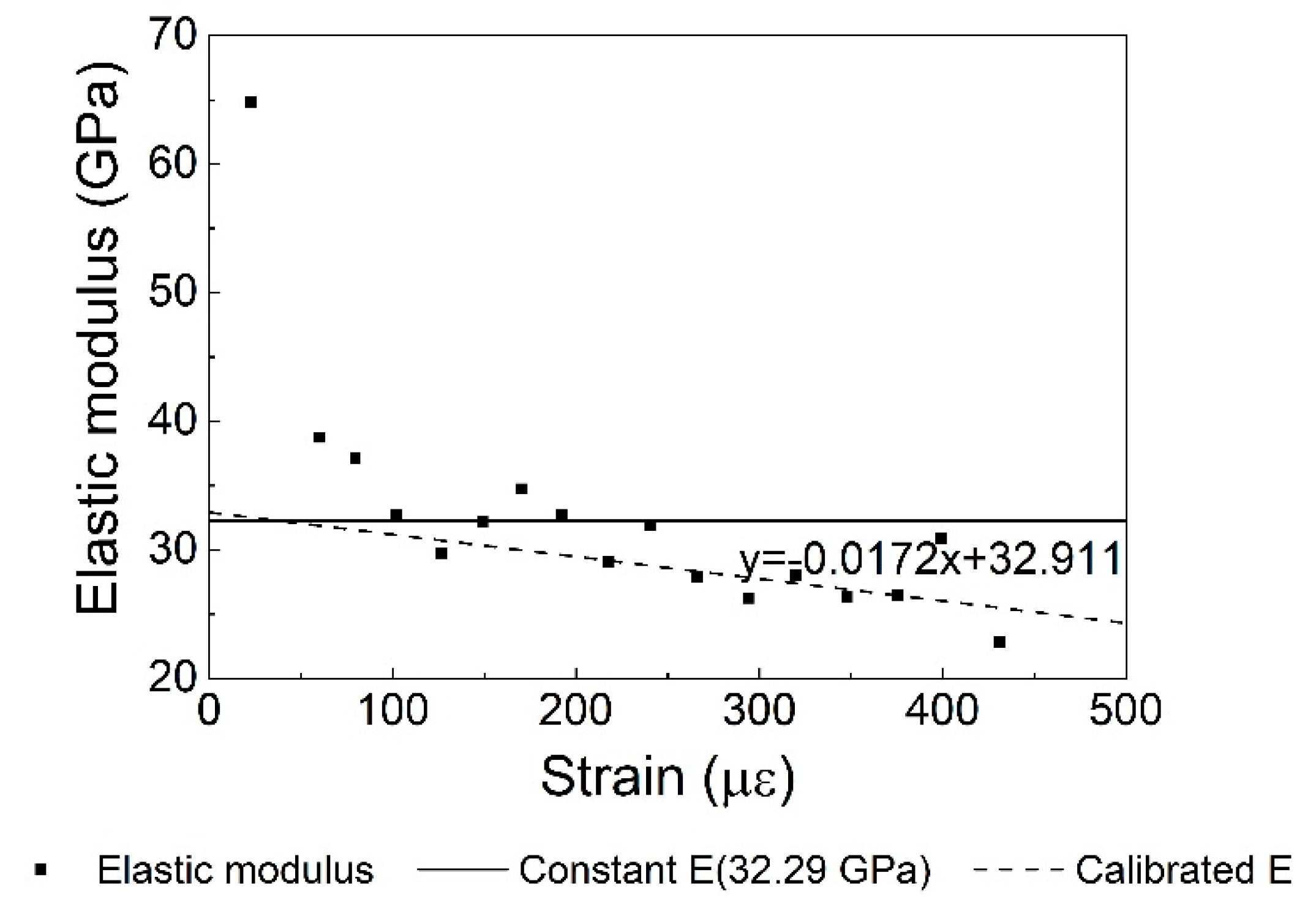


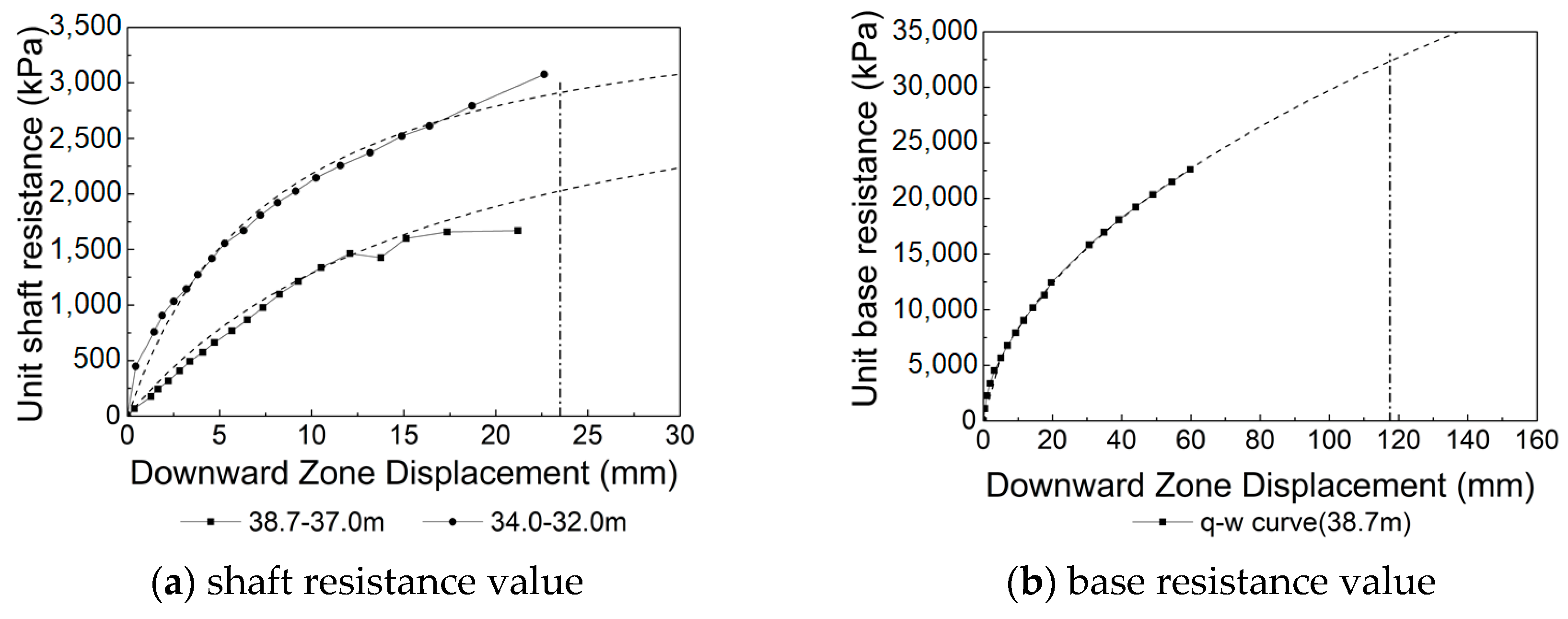
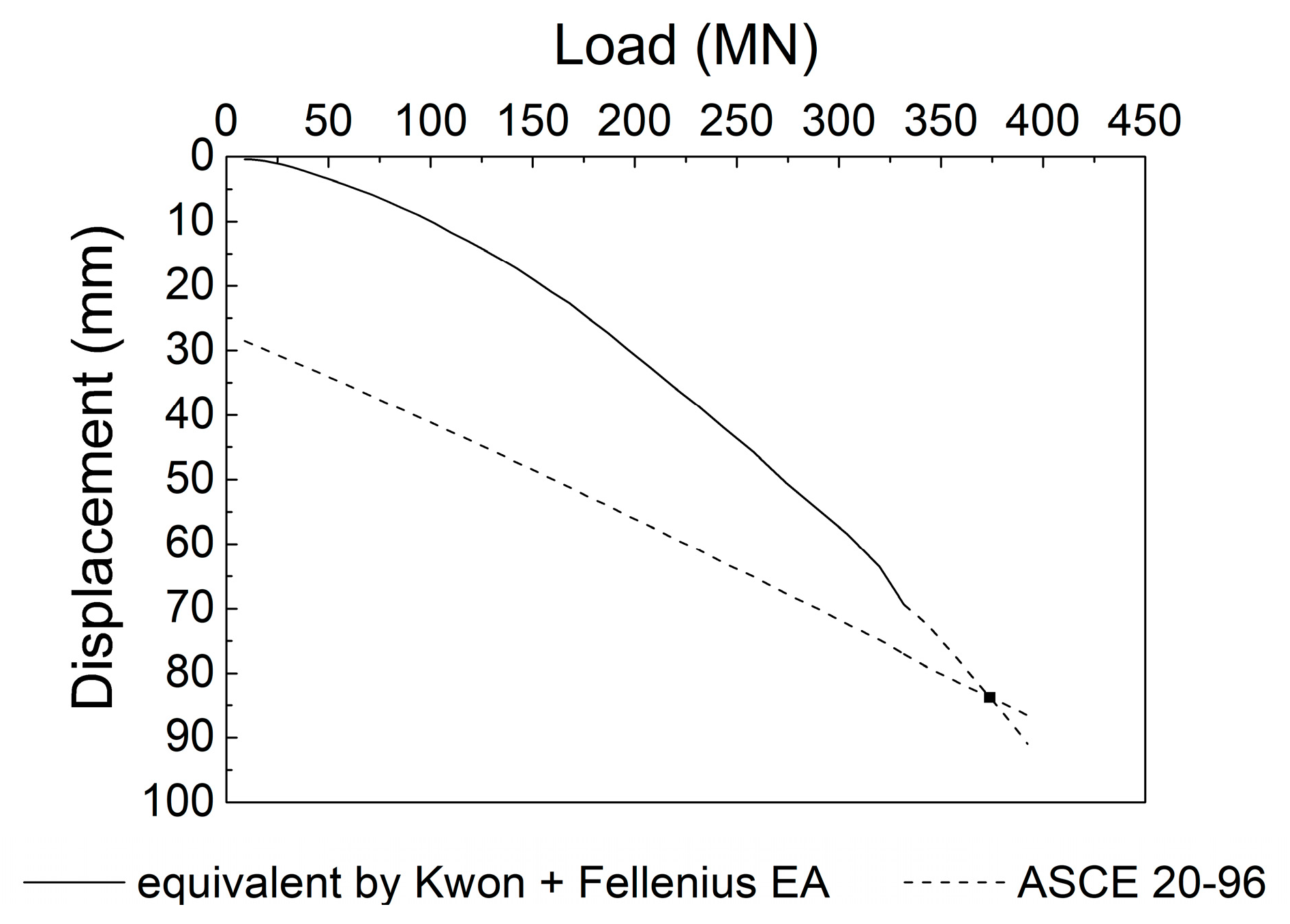

| Shaft No. | Shaft Length (m) | Embedded Depth (m) | Shaft Diameter (m) | Construction Site | Rock Type | Weathering Degree* | Unconfined Strength (MPa) | RQD (%) | TCR (%) |
|---|---|---|---|---|---|---|---|---|---|
| TP 1 | 18.96 | 38.96 | 2.35 | Site 1 (Bridge) | Gneiss & schist | Weathered and soft rock | 3.1–19.8 | 0–13 | 54–100 |
| TP 2 | 20.61 | 36.21 | 1.85 | Weathered and soft rock | 10.2–25.4 | 22–78 | 53–100 | ||
| TP 3 | 9.11 | 33.41 | 1.35 | Weathered and soft rock | 5.6–25.0 | 25–72 | 80–100 | ||
| TP 4 | 35.38 | 36.38 | 1.85 | Weathered and soft rock | 1.8–8.7 | 4–35 | 30–100 | ||
| TP 5 | 40.14 | 55.42 | 3 | Site 2 (Bridge) | Biotite granite | Weathered and soft rock | 30.4–194 | 0–68 | 51–100 |
| TP 6 | 44.10 | 56.60 | 2.4 | Weathered rock | 5–14 | 0–36 | 20–100 | ||
| TP 7 | 45.10 | 51.20 | 2.4 | Biotite granite & pegmatite | Weathered and soft rock | 44–47 | 0–42 | 90–100 | |
| TP 8 | 40.01 | 52.26 | 2.4 | Pegmatite, gneiss, & aplite | Weathered and soft rock | 1–192 | 0–55 | 30–100 | |
| TP 9 | 14.0 | 14.0 | 1.5 | Site 3 (Building) | Gneiss | Weathered rock | 71.4–87.2 | - | - |
| TP 10 | 13.5 | 13.5 | 1.0 | Highly weathered rock | 38 | 0 | 50 | ||
| TP 11 | 13.5 | 13.5 | 1.0 | Highly weathered rock | 38 | 0 | 100 | ||
| TP 12 | 13.5 | 13.5 | 1.0 | Highly weathered rock | 38 | 18–42 | 100 | ||
| TP 13 | 13.5 | 13.5 | 1.0 | Highly weathered rock | 38 | 23–61 | 100 |
| Shaft No. | Loading Type | Load (MN) |
|---|---|---|
| TP 1 | Bi-directional loading test | 105.5 |
| TP 2 | 49.1 | |
| TP 3 | 44.1 | |
| TP 4 | 36.8 | |
| TP 5 | 206.0 | |
| TP 6 | 166.8 | |
| TP 7 | 117.7 | |
| TP 8 | 88.3 | |
| TP 9 | Top-down static loading test | 19.1 |
| TP 10 | 17.7 | |
| TP 11 | 17.7 | |
| TP 12 | 17.7 | |
| TP 13 | 17.7 |
| Shaft No. | Calibrated Elastic Modulus for Load Test Transfer Analysis | Calibrated Load Ratio for the Equivalent Load-Displacement Curve | |
|---|---|---|---|
| Load Ratio | |||
| TP1 | 32.29 | 32.910.0172 | 1.00 |
| TP2 | 34.67 | 29.19–0.0258 | 3.82 |
| TP3 | 37.97 | 35.71–0.0177 | 1.00 |
| TP4 | 37.74 | 37.78–0.0007 | 1.00 |
| TP5 | 33.13 | 41.26–0.0374 | 4.44 |
| TP6 | 39.72 | 35.66–0.0108 | 4.31 |
| TP7 | 38.15 | 40.81–0.0160 | 1.22 |
| TP8 | 36.39 | 42.02–0.0214 | 1.42 |
| (a) Shaft resistance. | |||
| Resistance component | Design method | Bearing capacity equation | Parameter |
| Shaft resistance | Carter & Kulhawy (1988) | : Unconfined compressive strength of rock core (kPa) | |
| Horvath & Kenney (1979) | : Unconfined compressive strength of rock core (kPa) | ||
| FHWA (1999) | : Atmospheric pressure = 101 kPa : Unconfined compressive strength of rock core (kPa) | ||
| Rowe & Armitage (1987) | : Unconfined compressive strength of rock core (kPa) | ||
| (b) base resistance. | |||
| Resistance component | Design method | Bearing capacity equation | Parameter |
| Base resistance | Carter & Kulhawy (1988) | m,s: Mass properties : Unconfined compressive strength of rock core (kPa) | |
| FHWA (1999) | : Emperical factor θ: Depth factor : Unconfined compressive strength of rock core (kPa) | ||
| Zhang & Einstein (1998) | : Unconfined compressive strength of rock core (kPa) | ||
| (c) total resistance. | |||
| Resistance component | Design method | Bearing capacity equation | Parameter |
| Total resistance | Carter & Kulhawy (1988) | : Unconfined compressive strength of rock core (kPa) | |
| m,s: Mass properties : Unconfined compressive strength of rock core (kPa) | |||
| FHWA (1999) | : Atmospheric pressure = 101 kPa : Unconfined compressive strength of rock core (kPa) | ||
| : Emperical factor θ: Depth factor : Unconfined compressive strength of rock core (kPa) | |||
| 1.05 | 0.10 | 1.15 | 0.20 |
| Shaft No. | Depth (m) | Measured Shaft Resistance (MPa) | Carter & Kulhawy (1988) | Horvath & Kenney (1979) | FHWA (1999) | Rowe & Armitage (1987) | ||||
|---|---|---|---|---|---|---|---|---|---|---|
| Predicted Resistance (MPa) | Bias Factor | Predicted Resistance (MPa) | Bias Factor | Predicted Resistance (MPa) | Bias Factor | Predicted Resistance (MPa) | Bias Factor | |||
| TP1 | 35.0–36.0 | 1.22 | 0.36 | 1.53 | 0.38 | 1.44 | 0.36 | 1.51 | 0.83 | 0.66 |
| 36.0–37.0 | 2.45 | 0.80 | 3.18 | 0.85 | 2.99 | 0.81 | 3.15 | 1.84 | 1.38 | |
| 37.0–38.7 | 1.90 | 0.77 | 2.09 | 0.82 | 1.96 | 0.78 | 2.07 | 1.77 | 0.91 | |
| TP2 | 28.8–32.9 | 0.81 | 0.89 | 0.9 | 0.95 | 0.85 | 0.90 | 0.89 | 2.06 | 0.39 |
| 32.9–33.9 | 0.89 | 0.77 | 1.16 | 0.82 | 1.09 | 0.78 | 1.14 | 1.77 | 0.5 | |
| 33.9–35.3 | 2.06 | 1.03 | 2 | 1.10 | 1.88 | 1.04 | 1.98 | 2.37 | 0.87 | |
| TP3 | 26.9–28.0 | 0.68 | 0.57 | 1.19 | 0.61 | 1.12 | 0.58 | 1.18 | 1.32 | 0.52 |
| 28.0–29.0 | 0.37 | 0.65 | 0.57 | 0.69 | 0.54 | 0.66 | 0.56 | 1.50 | 0.25 | |
| 29.0–30.0 | 1.40 | 0.82 | 1.7 | 0.88 | 1.6 | 0.83 | 1.69 | 1.90 | 0.74 | |
| 30.0–31.0 | 1.79 | 0.81 | 2.21 | 0.86 | 2.08 | 0.82 | 2.19 | 1.86 | 0.96 | |
| 31.0–33.1 | 2.69 | 0.67 | 4.02 | 0.71 | 3.78 | 0.68 | 3.98 | 1.54 | 1.74 | |
| TP4 | 24.0–30.5 | 0.24 | 0.27 | 0.87 | 0.29 | 0.82 | 0.28 | 0.86 | 0.63 | 0.38 |
| TP5 | 44.0–46.5 | 0.32 | 2.18 | 0.15 | 2.32 | 0.14 | 2.20 | 0.15 | 5.01 | 0.06 |
| 46.5–48.5 | 2.85 | 2.58 | 1.1 | 2.75 | 1.04 | 2.61 | 1.09 | 5.95 | 0.48 | |
| 48.5–50.5 | 2.00 | 2.85 | 0.7 | 3.03 | 0.66 | 2.88 | 0.69 | 6.56 | 0.3 | |
| 50.5–52.5 | 1.44 | 2.67 | 0.54 | 2.84 | 0.51 | 2.69 | 0.54 | 6.14 | 0.23 | |
| 52.5–54.5 | 1.52 | 1.26 | 1.2 | 1.34 | 1.13 | 1.27 | 1.19 | 2.90 | 0.52 | |
| TP7 | 45.5–50.21 | 3.35 | 1.36 | 2.46 | 1.45 | 2.31 | 1.37 | 2.44 | 3.13 | 1.07 |
| TP8 | 46.26–48.26 | 1.22 | 0.28 | 4.36 | 0.30 | 4.1 | 0.28 | 4.32 | 0.64 | 1.89 |
| 48.26–49.76 | 1.17 | 0.38 | 3.04 | 0.41 | 2.85 | 0.39 | 3.01 | 0.88 | 1.32 | |
| 49.76–51.35 | 1.60 | 0.55 | 2.9 | 0.59 | 2.73 | 0.56 | 2.87 | 1.27 | 1.26 | |
| Shaft No. | Depth (m) | Measured Base Resistance (MPa) | Carter & Kulhawy (1988) | FHWA (1999) | Zhang & Einstein (1999) | |||
|---|---|---|---|---|---|---|---|---|
| Predicted Resistance (MPa) | Bias Factor | Predicted Resistance (MPa) | Bias Factor | Predicted Resistance (MPa) | Bias Factor | |||
| TP 1 | 38.96 | 32.33 | 11.76 | 2.75 | 12.71 | 2.54 | 21.91 | 1.48 |
| TP 2 | 36.21 | 40.43 | 10.64 | 3.80 | 18.92 | 2.14 | 26.42 | 1.53 |
| TP 3 | 33.41 | 46.68 | 61.92 | 0.75 | 93.65 | 0.50 | 31.70 | 1.47 |
| TP 5 | 55.42 | 55.73 | 105.72 | 0.53 | 151.32 | 0.37 | 49.83 | 1.12 |
| TP 7 | 51.2 | 35.01 | 14.15 | 2.48 | 34.17 | 1.02 | 34.42 | 1.02 |
| TP 8 | 52.26 | 23.94 | 26.30 | 0.91 | 19.94 | 1.20 | 31.12 | 0.77 |
| TP 10 | 13.5 | 10.13 | 9.49 | 1.07 | 20.52 | 0.49 | 30.88 | 0.33 |
| TP 11 | 13.5 | 14.75 | 9.49 | 1.55 | 21.43 | 0.69 | 30.88 | 0.48 |
| TP 12 | 13.5 | 32.94 | 26.50 | 1.24 | 20.52 | 1.61 | 30.88 | 1.07 |
| TP 13 | 13.5 | 13.24 | 33.49 | 0.40 | 20.52 | 0.65 | 30.88 | 0.43 |
| Shaft No. | Depth (m) | Measured Total Resistance (MN) | Carter & Kulhawy (1988) | FHWA (1999) | ||
|---|---|---|---|---|---|---|
| Predicted Resistance (MN) | Bias Factor | Predicted Resistance (MN) | Bias Factor | |||
| TP 1 | 38.96 | 373.86 | 83.60 | 4.47 | 88.07 | 4.25 |
| TP 2 | 36.21 | 144.85 | 64.49 | 2.25 | 87.09 | 1.66 |
| TP 3 | 33.41 | 151.50 | 107.23 | 1.41 | 152.83 | 0.99 |
| TP 5 | 55.42 | 335.88 | 854.78 | 0.39 | 1147.41 | 0.29 |
| TP 7 | 51.2 | 356.00 | 101.48 | 3.51 | 181.52 | 1.96 |
| TP 8 | 52.26 | 200.61 | 118.79 | 1.69 | 93.65 | 2.14 |
| (a) Shaft resistance. | ||||
| Design method | Pile no. | Mean () | Standard deviation | Coefficient of variation |
| Carter & Kulhawy (1988) | 21 | 1.80 | 1.17 | 0.65 |
| Horvath & Kenney (1979) | 21 | 1.70 | 1.10 | 0.65 |
| FHWA (1999) | 21 | 1.79 | 1.16 | 0.65 |
| Rowe & Armitage (1987) | 21 | 0.78 | 0.51 | 0.65 |
| (b) Base resistance. | ||||
| Design method | Pile no. | Mean ( ) | Standard deviation | Coefficient of variation |
| Carter & Kulhawy (1988) | 9 | 1.30 | 0.83 | 0.64 |
| FHWA (1999) | 10 | 1.12 | 0.75 | 0.67 |
| Zhang & Einstein (1998) | 10 | 0.97 | 0.45 | 0.47 |
| (c) Total resistance. | ||||
| Design method | Pile no. | Mean ( ) | Standard deviation | Coefficient of variation |
| Carter & Kulhawy (1988) | 6 | 2.29 | 1.48 | 0.65 |
| FHWA (1999) | 6 | 1.88 | 1.34 | 0.71 |
| (a) Shaft resistance. | ||||
| Bearing capacity equation | Reliability index () | |||
| FS = 2.0 | FS = 3.0 | FS = 4.0 | FS = 5.0 | |
| Carter & Kulhawy (1988) | 1.73 | 2.40 | 2.88 | 3.25 |
| Horvath & Kenney (1979) | 1.62 | 2.30 | 2.78 | 3.15 |
| FHWA (1999) | 1.71 | 2.39 | 2.87 | 3.24 |
| Rowe & Armitage (1987) | 0.34 | 1.01 | 1.49 | 1.86 |
| (b) Base resistance. | ||||
| Bearing capacity equation | Reliability index () | |||
| FS = 2.0 | FS = 3.0 | FS = 4.0 | FS = 5.0 | |
| Carter & Kulhawy (1988) | 1.20 | 1.89 | 2.37 | 2.75 |
| FHWA (1999) | 0.89 | 1.41 | 2.02 | 2.38 |
| Zhang & Einstein (1998) | 1.08 | 1.97 | 2.60 | 3.08 |
| (c) Total resistance. | ||||
| Bearing capacity equation | Reliability index () | |||
| FS = 2.0 | FS = 3.0 | FS = 4.0 | FS = 5.0 | |
| Carter & Kulhawy (1988) | 2.12 | 2.80 | 3.26 | 3.65 |
| FHWA (1999) | 1.61 | 2.24 | 2.68 | 3.03 |
| (a) Shaft resistance. | ||||
| Bearing capacity equation | Resistance factor | Note | ||
| = 2.5 | = 3.0 | = 3.5 | AASHTO (2015) = 3.0 | |
| Carter & Kulhawy (1988) | 0.45 | 0.32 | 0.24 | 0.5 |
| Horvath & Kenney (1979) | 0.42 | 0.30 | 0.22 | 0.55 |
| FHWA (1999) | 0.44 | 0.32 | 0.24 | 0.55 |
| Rowe & Armitage (1987) | 0.19 | 0.13 | 0.11 | - |
| (b) Base resistance. | ||||
| Bearing capacity equation | Resistance factor | Note | ||
| = 2.5 | = 3.0 | = 3.5 | AASHTO (2015) = 3.0 | |
| Carter & Kulhawy (1988) | 0.32 | 0.24 | 0.21 | 0.5 |
| FHWA (1999) | 0.25 | 0.19 | 0.17 | 0.5 |
| Zhang & Einstein (1998) | 0.37 | 0.29 | 0.24 | - |
| (c) Total resistance. | ||||
| Bearing capacity equation | Resistance factor | Note | ||
| = 2.5 | = 3.0 | = 3.5 | AASHTO (2015) = 3.0 | |
| Carter & Kulhawy (1988) | 0.57 | 0.42 | 0.30 | - |
| FHWA (1999) | 0.40 | 0.28 | 0.22 | - |
© 2019 by the authors. Licensee MDPI, Basel, Switzerland. This article is an open access article distributed under the terms and conditions of the Creative Commons Attribution (CC BY) license (http://creativecommons.org/licenses/by/4.0/).
Share and Cite
KIM, S.J.; KWON, S.Y.; HAN, J.T.; YOO, M. Development of Rock Embedded Drilled Shaft Resistance Factors in Korea based on Field Tests. Appl. Sci. 2019, 9, 2201. https://doi.org/10.3390/app9112201
KIM SJ, KWON SY, HAN JT, YOO M. Development of Rock Embedded Drilled Shaft Resistance Factors in Korea based on Field Tests. Applied Sciences. 2019; 9(11):2201. https://doi.org/10.3390/app9112201
Chicago/Turabian StyleKIM, Seok Jung, Sun Yong KWON, Jin Tae HAN, and Mintaek YOO. 2019. "Development of Rock Embedded Drilled Shaft Resistance Factors in Korea based on Field Tests" Applied Sciences 9, no. 11: 2201. https://doi.org/10.3390/app9112201
APA StyleKIM, S. J., KWON, S. Y., HAN, J. T., & YOO, M. (2019). Development of Rock Embedded Drilled Shaft Resistance Factors in Korea based on Field Tests. Applied Sciences, 9(11), 2201. https://doi.org/10.3390/app9112201





